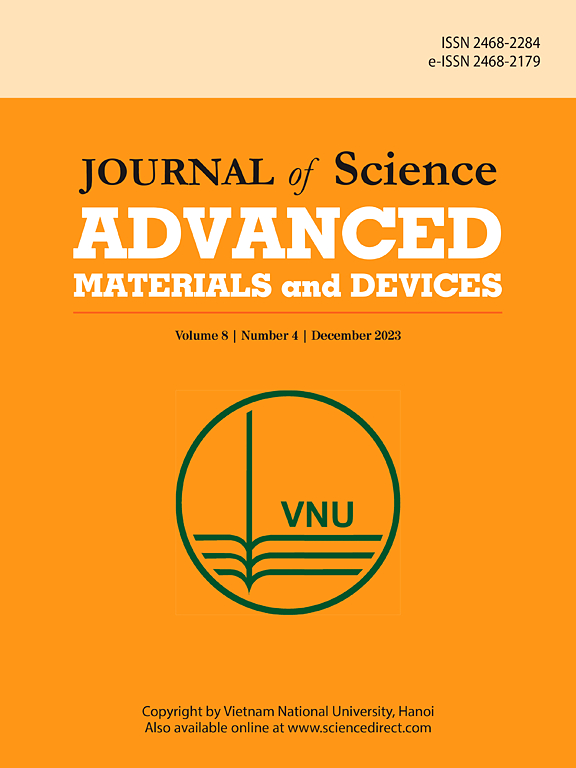Pt/ZnO and Pt/few-layer graphene/ZnO Schottky devices with Al ohmic contacts using Atlas simulation and machine learning
IF 6.7
3区 材料科学
Q1 MATERIALS SCIENCE, MULTIDISCIPLINARY
Journal of Science: Advanced Materials and Devices
Pub Date : 2024-10-19
DOI:10.1016/j.jsamd.2024.100798
引用次数: 0
Abstract
The search for highly efficient photodetectors, driven by various applications ranging from environmental monitoring to communication systems and imaging, continues to drive research into novel materials and innovative device architectures. This paper offers an in-depth comparative analysis to optimize the performance of two types of Schottky ultraviolet (UV) photodetectors: platinum (Pt)/zinc oxide (ZnO) and Pt/few-layer graphene (FLG)/ZnO, both featuring aluminum (Al) ohmic contacts. The study systematically examines and compares the electrical and optical characteristics of these two photodetector configurations using the Silvaco TCAD simulation tool and machine learning regression models. The research outcomes demonstrate that the proposed photodetector configurations exhibit remarkable improvements, showcasing their substantial potential for superior performance in UV applications. The Pt/ZnO photodetector demonstrates a dark current density of 8.2 × 10−11 pA/cm2, a photocurrent density of 0.26 μA/cm2, a 3-dB cut-off frequency of 85.4 GHz, an external quantum efficiency of 90.41%, and an external photocurrent responsivity of 0.26A/W, at a bias of −1.0 V. On the other hand, Pt/FLG/ZnO photodetector demonstrates near zero dark current density, a photocurrent density of 0.2 μA/cm2, a 3-dB cut-off frequency of 2.44 THz, an external quantum efficiency of 68.52%, and an external photocurrent responsivity of 0.2 A/W at a bias of −1.0 V. Furthermore, a comprehensive comparative analysis of various machine-learning regression models is conducted, validating the simulation findings and providing a predictive framework for optimizing the photodetector's performance. Each machine-learning regression model is evaluated by getting root mean squared error and R2 values across different test set sizes to assess their accuracy in predicting the photodetector's characteristics. This study underscores the promising role of cutting-edge materials and computational techniques in advancing the development of next-generation optoelectronic devices with enhanced capabilities and performance.
利用 Atlas 仿真和机器学习技术实现带有铝欧姆触点的 Pt/ZnO 和 Pt/ 少层石墨烯/ZnO 肖特基器件
在从环境监测到通信系统和成像等各种应用的推动下,对高效光电探测器的探索继续推动着对新型材料和创新器件结构的研究。本文通过深入的比较分析,优化了两种类型的肖特基紫外线(UV)光电探测器的性能:铂(Pt)/氧化锌(ZnO)和铂/少层石墨烯(FLG)/ZnO,两者均采用铝(Al)欧姆触点。该研究利用 Silvaco TCAD 仿真工具和机器学习回归模型,系统地研究和比较了这两种光电探测器配置的电气和光学特性。研究结果表明,所提出的光电探测器配置具有显著的改进,展示了其在紫外应用中实现卓越性能的巨大潜力。Pt/ZnO 光电探测器的暗电流密度为 8.2 × 10-11 pA/cm2,光电流密度为 0.26 μA/cm2,3 分贝截止频率为 85.4 GHz,外部量子效率为 90.41%,外部光电流响应率为 0.26A/W(偏压为 -1.0 V)。另一方面,Pt/FLG/氧化锌光电探测器的暗电流密度接近零,光电流密度为 0.2 μA/cm2,3-dB 截止频率为 2.44 THz,外部量子效率为 68.52%,外部光电流响应率为 0.2 A/W(偏压为 -1.0 V)。此外,还对各种机器学习回归模型进行了全面的比较分析,从而验证了模拟结果,并为优化光电探测器的性能提供了一个预测框架。每个机器学习回归模型都通过不同测试集大小的均方根误差和 R2 值进行评估,以评估其预测光电探测器特性的准确性。这项研究强调了前沿材料和计算技术在推动具有更强功能和性能的下一代光电器件开发中的重要作用。
本文章由计算机程序翻译,如有差异,请以英文原文为准。
求助全文
约1分钟内获得全文
求助全文
来源期刊

Journal of Science: Advanced Materials and Devices
Materials Science-Electronic, Optical and Magnetic Materials
CiteScore
11.90
自引率
2.50%
发文量
88
审稿时长
47 days
期刊介绍:
In 1985, the Journal of Science was founded as a platform for publishing national and international research papers across various disciplines, including natural sciences, technology, social sciences, and humanities. Over the years, the journal has experienced remarkable growth in terms of quality, size, and scope. Today, it encompasses a diverse range of publications dedicated to academic research.
Considering the rapid expansion of materials science, we are pleased to introduce the Journal of Science: Advanced Materials and Devices. This new addition to our journal series offers researchers an exciting opportunity to publish their work on all aspects of materials science and technology within the esteemed Journal of Science.
With this development, we aim to revolutionize the way research in materials science is expressed and organized, further strengthening our commitment to promoting outstanding research across various scientific and technological fields.
 求助内容:
求助内容: 应助结果提醒方式:
应助结果提醒方式:


